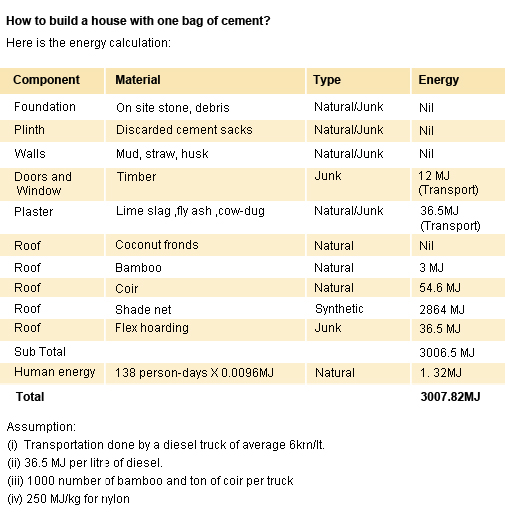Earth: A humble material
Once in a conversation with an eminent architect in Bangalore I asked -"what are sustainable buildings, or sustainable architecture?" He calmly replied. "Sustainable architecture is a myth; we can definitely build energy efficient buildings, but sustainable buildings cannot be constructed since it requires huge amount of energy to build. In case you want to practice sustainable architecture, convince your client not to build, then question his needs and if you fail in that then provide an optimum approach to make a resource efficient building. In case you really want to follow sustainability, practise it in the lifestyle." This thought provoking answer shattered my perception about architecture, but created interest in a humble approach towards the built mass, and in search of that simplicity, I came across Earth as a construction material.
Earth/Mud construction is one of the oldest construction technologies in the history of mankind, and the oldest mud structure still standing was built almost 5,000 years ago. The largest mud structure still existing was built in year 1907 and currently more than 3 billion people in world either live or work in buildings constructed out of mud.
The oldest mud structure is much older than few civilizations on earth. Many of them are older than invention of concrete and are standing after witnessing many natural calamities. Mud is aesthetically and functionally a versatile material and has been largely accepted in urban setting. Architect Chitra Vishwanath in Bangalore has constructed more than 500 mud bungalows in Bangalore. Didi contractor, an 82 years old lady is still constructing mud houses in the vicinity of Dharamshala. Indian Institute of Science, Bangalore is doing extensive research in mud construction, while Development Alternative, Delhi and COSTFORD, Kerala is working with mud for sustainable development.
In most parts of the country, the soil available is fit for construction. Few places where there is sandy soil, sub surface earth could be used for construction, or it can be made suitable for construction after stabilizing. The best practice is to find mud at site or to take it from nearest construction site. It is preferred to avoid first 6-9 inches of soil since it contains organic mass, which is highly fertile and not good for construction but can be used for landscaping.
The soil can be tested by basic tests at site to check if it is suitable for construction. Mud can be used in following ways - Cob, Adobe, Wattle and Daub, Rammed Earth and Compressed, Stabilized Earth Block. These methodologies of construction can be adopted depending on the typology, scale and usage of the building.
Mud has certain limitations, but so do all the materials. It is important to keep the mud structure dry in case of heavy rainfall, which can be done by using proper overhang and a good foundation.
One of the most beautiful characteristic about mud is that it creates a bonding between the building, workers and building occupant. There is a wide range of mud and each has its own individual characteristic which reflects in the spatial expression of building.
The scope of architecture and role of architects sprawl to a large extent, where shelter is basic necessity, architecture is also termed as a 'social art1. An architect tries to figure out his space in that scope of architecture.
In densely populated area of Pune city, an architect turned school teacher decided to build a small house for himself inside the school campus, intended to be an off-the-grid core residence + workplace consisting of a living space kitchenette, workspace, bathroom, compost toilet and bedroom loft. The building was planned to be constructed out of mud or materials discarded as junk.
Stone and construction debris was used as foundation, plinth was made of discarded cement bags filled with earth from the site, and damp proof course was made of discarded Ilex walls of dug up earth stabilized with rice husk and waste straw from sanitary shops. Bamboo was used for making reciprocal roof structure covered coconut leaves, waste flex for water proofing and a shade net. While doors and windows were bought from scrap timber stores, the structure as finished with cow dung and mud plaster. The building evolved from the ground, and after the lease gets over, if demolished, it will decompose to its origin. During construction it created an intangible bond with the worker, after 1.2-ft of cobbing, the wall started to slop, as if it said to the worker, "I am tired and so are you, don't build more." Many volunteers from the vicinity came to help in construction. It not only revived an old concept of 'shramdari but transformed building into a learning process. Sukalatti was constructed in six months. It witnessed heavy rains, harsh sun, lots of experimentation and little failure and when the building got completed, it created everlasting relationship. Today, while we are in the vicious cycle of form and function, the building, which was constructed as a house of the teacher humbly sacrificed its function and is used as classroom to teach pre-primary children of the school. I don't think this attitude can be attained by any other construction material.

We can see that from the above table that the total amount of energy required to build Sukalatti is the same amount of energy required to produce fifty bags of cement in a factory, where the nylon shed consumes more than 95 per cent of total energy. So, just a little thought on roofing material, and we can built a house by using energy required to produce one bag of cement.
As someone rightly said 'An architect choose material to represent his structure; just like an artist choose colours and that is symbolism in architecture.'

